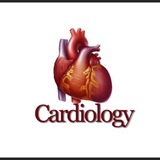❤️Differential Diagnosis of Wide QRS Tachycardias⤵️ ECG Criteria
🔹Measurement of R-wave Peak Time in Lead II
🔹The Brugada Algorithm
🔹The Vereckei algorithm
🔹QRS Axis
🔹Chest Lead Concordance
🔹Right Bundle Branch Block Morphology
🔹Left Bundle Branch Block Morphology
🔹RS Interval in the Precordial Leads
🔹QRS Complex in the aVR Lead
🔹R-wave Peak Time at Lead II ≥50 ms
https://www.tg-me.com/cardiology
🔹Measurement of R-wave Peak Time in Lead II
🔹The Brugada Algorithm
🔹The Vereckei algorithm
🔹QRS Axis
🔹Chest Lead Concordance
🔹Right Bundle Branch Block Morphology
🔹Left Bundle Branch Block Morphology
🔹RS Interval in the Precordial Leads
🔹QRS Complex in the aVR Lead
🔹R-wave Peak Time at Lead II ≥50 ms
https://www.tg-me.com/cardiology
🔴Advanced Echo Cards!
✅TEE
✅Cardiac Output
✅Tamponade
✅Diastology
✅EF Calcs
✅Right 💔 Failure
✅Wall Motion Abnl
https://www.tg-me.com/cardiology
✅TEE
✅Cardiac Output
✅Tamponade
✅Diastology
✅EF Calcs
✅Right 💔 Failure
✅Wall Motion Abnl
https://www.tg-me.com/cardiology
Mechanisms of
Cardiovascular Benefits of
Sodium Glucose Co-Transporter 2 (SGLT2)
Inhibitors:
https://www.tg-me.com/cardiology
Cardiovascular Benefits of
Sodium Glucose Co-Transporter 2 (SGLT2)
Inhibitors:
https://www.tg-me.com/cardiology
SAVE THESE CARDS
FATE stands for Focus Assessed Transthoracic Echocardiography.
It is a rapid, point-of-care ultrasound protocol used primarily in critical care and emergency settings for assessing cardiac function
FATE is designed to be performed by non-cardiologists, such as intensivists or emergency physicians, with basic training in ultrasound.
In a nutshell
OBJECTIVE ~ To provide a rapid assessment of the heart to guide immediate clinical decisions in critically ill patients.
VIEWS ~ The FATE protocol entails 5 standard transthoracic echocardiography views:
1. Subcostal four-chamber view
2. Apical four-chamber view
3. Parasternal long-axis view
4. Parasternal short-axis view
5. Subcostal inferior vena cava (IVC) view
Focus Areas: Evaluates:
• Left and right ventricular function (e.g., systolic dysfunction, dilatation)
• Pericardial effusion or tamponade
• Pleural effusion
• Volume status (via IVC assessment)
• Gross valvular abnormalities
ADVANTAGES
• Quick (can be done in minutes)
• Non-invasive
• Portable, performed at the bedside
• Guides interventions (e.g., fluid resuscitation, inotropic support)
LIMITATIONS
• Not a comprehensive echocardiogram
• Requires basic ultrasound skills
• May be limited by patient factors (e.g., obesity, poor acoustic windows)
https://www.tg-me.com/cardiology
FATE stands for Focus Assessed Transthoracic Echocardiography.
It is a rapid, point-of-care ultrasound protocol used primarily in critical care and emergency settings for assessing cardiac function
FATE is designed to be performed by non-cardiologists, such as intensivists or emergency physicians, with basic training in ultrasound.
In a nutshell
OBJECTIVE ~ To provide a rapid assessment of the heart to guide immediate clinical decisions in critically ill patients.
VIEWS ~ The FATE protocol entails 5 standard transthoracic echocardiography views:
1. Subcostal four-chamber view
2. Apical four-chamber view
3. Parasternal long-axis view
4. Parasternal short-axis view
5. Subcostal inferior vena cava (IVC) view
Focus Areas: Evaluates:
• Left and right ventricular function (e.g., systolic dysfunction, dilatation)
• Pericardial effusion or tamponade
• Pleural effusion
• Volume status (via IVC assessment)
• Gross valvular abnormalities
ADVANTAGES
• Quick (can be done in minutes)
• Non-invasive
• Portable, performed at the bedside
• Guides interventions (e.g., fluid resuscitation, inotropic support)
LIMITATIONS
• Not a comprehensive echocardiogram
• Requires basic ultrasound skills
• May be limited by patient factors (e.g., obesity, poor acoustic windows)
https://www.tg-me.com/cardiology
Telegram
Cardiology
👨💻 @dr_navruz
